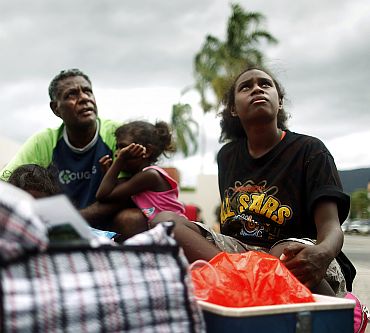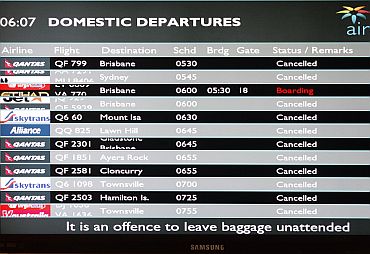 | « Back to article | Print this article |
Mother of all cyclones hits Australia
Cyclone 'Yasi', termed to be the mother of all cyclones, made landfall between Innisfail and Cardwell in the northeastern Australian state of Queensland minutes ago.
Mass evacuations have been underway in anticipation of what forecasters expect will be the largest cyclone ever to hit the continent since 1918.
Tropical cyclone Yasi became much more powerful and was upgraded to a dangerous category five tropical cyclone on the Saffir Simpson scale on February 1, 2011.
Click on NEXT to see more PHOTOS...
Mother of all cyclones hits Australia
According to news.com.au, the storm is continental in size.
The main bloc of the cyclone is 500km wide, while its associated activity, stretches over 2000km.
Assuming that the storm was to hit India, it would have claimed millions of lives and caused destruction worth billions.
Mother of all cyclones hits Australia
Queensland premier Anna Bligh said, "This impact is likely to be more life threatening than any experienced during recent generations"
Yasi was seen by the Tropical Rainfall Measuring Mission satellite when it passed over on Febuary 1, 2011. TRMM precipitation data collected with that pass revealed that the intensifying Yasi had a small eye surrounded by powerful thunderstorms
Mother of all cyclones hits Australia
Bligh urged inland residents in areas west of Cairns and Townsville to be prepared as Yasi moves into the interior of the state.
The Atherton Tablelands, Hinterlands and regions to the west are pointed out as the areas need to brace for cyclonic conditions.
Mother of all cyclones hits Australia
She said only those who would be inundated should move, and others should bunker down or stay with friends.
Mother of all cyclones hits Australia
"You are safer in your own home and you will only take up space from people who cannot be in their own home or the home of a friend," she said.
She said large trees were already being brought down as the region started to see the effects of Yasi.
Mother of all cyclones hits Australia
Wind gusts at the core of the cyclone are already at 295km/h, Bligh said.
Mother of all cyclones hits Australia
State disaster management co-ordinator Ian Stewart said the storm surge at Cardwell was likely to be 6.5 to seven metres.
"That means a person who lives in that area who knows what...the highest tide level is, they can expect water above that, through the storm surge of up to 20 feet," he said.
Mother of all cyclones hits Australia
He said water would build up over coming hours as the tide rises. In Townsville, the height is around the three metre mark, he said.
Mother of all cyclones hits Australia
Stewart said authorities were prepared as much as they could be.
The navy were prepared to bring their ships to the coast so that authorities could use them as bases if necessary, like during the tsunami response in Indonesia, he added.
Mother of all cyclones hits Australia
They warn that people should now be bunkered down in homes or among the thousands who have moved into one of 20 evacuation centres across the region.
For more information on Cyclone Yasi, visit: Bureau of Meteorology, Government of Australia










